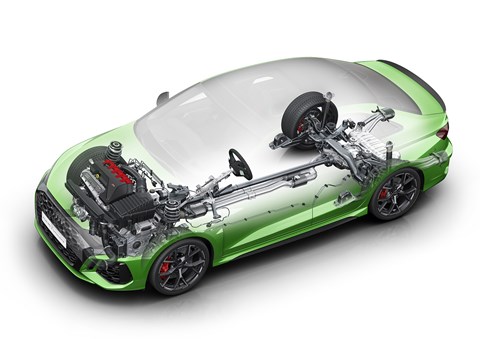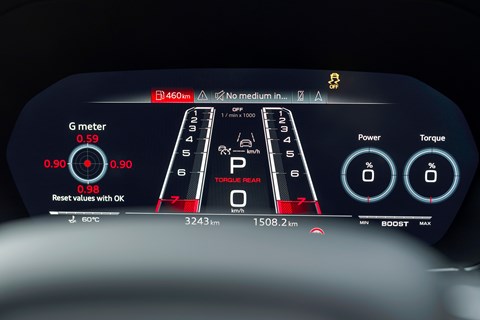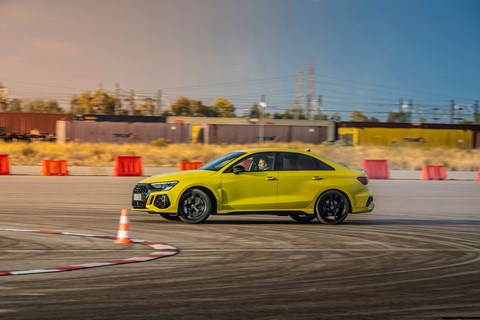► Audi’s drift mode tech on test
► New RS3’s Torque Splitter
► Next-level torque vectoring examined
There’s an ear-splitting howl of tortured tyres and smoke filling the air. The new Audi RS3 pivots sideways like a trolley that’s spotted a gap in a Christmas shopping queue and then, aided by a careful bit of steering-wheel juggling, the car is suspended in a huge circular powerslide.
This is the all-wheel-drive RS3’s party piece, Torque Rear mode, made possible by some clever software and the Torque Splitter, Audi’s name for the rear axle’s drive unit. Instead of a normal differential, the propshaft has its drive taken off at right angles by two T-junctioned gears to an electronically controlled multi-disc clutch unit at each side.
The Modular Vehicle Dynamics Controller (MVDC) networks the Torque Splitter with sensors throughout the car, and works out how much torque to apportion to each rear wheel. (On this latest RS3, at least half the total torque output always goes to the front wheels.)
In normal driving, the Torque Splitter (below) sends slightly more torque to the outside wheel to help turn the car, hold its line and avoid understeer. In sticky or slippy conditions, it switches torque to the inside wheel to help straighten things up.

Torque Rear mode is for showboating. It lets the Splitter send 100 per cent of rear torque to the outside wheel alone, to instigate a slide. It’s clever enough to sense when you’re doing it on purpose, and then balances torque side-to-side to help keep the drift going.
The VW Golf R uses similar hardware but Audi says its MVDC makes Torque Rear more sophisticated. The now-retired Ford Focus RS’s GKN Twinster rear axle used electronically controlled clutches too but was geared to a different ratio from the rest of the driveline to help instigate slides, which isn’t the case here.
Like the Focus RS in Drift Mode, sliding the RS3 in Torque Rear doesn’t feel entirely natural. Our test of the system took place on a vast area of tarmac with nothing to hit but cones. Would I feel comfortable trying it on the road? Not a chance. Selecting Torque Rear flashes up messages on the screen to tell you it’s for use on a closed circuit only.
Really, all this sideways stuff is a bit of a puerile gimmick (albeit a very fun one). The Torque Splitter’s real strength is in making the RS3 (and other fast Audis in the future) feel more positive and less inert in regular driving.
Does Audi’s drift mode work?
Yes, and it’s a lot of fun, although it’s not altogether natural, and sliding a rear-wheel-drive car with a limited-slip differential feels more intuitive. The RS3’s Torque Splitter is most worthwhile for boosting agility in normal, non-sideways driving.
Drifting an RS3: how it works

1) Switch to Torque Rear
From the drive modes selection screen, select Torque Rear (out of the way at the bottom-right, so you don’t press it by accident)

2) Switch off the TC
Check the special ‘runway’ dials for the little squiggly yellow car, ensuring the traction control’s switched off

3) Set tyres on fire
Turn wheel, hoof throttle, choke on the stench of burnt rubber (and then again at the tyre bill)
More automotive tech stories by CAR magazine